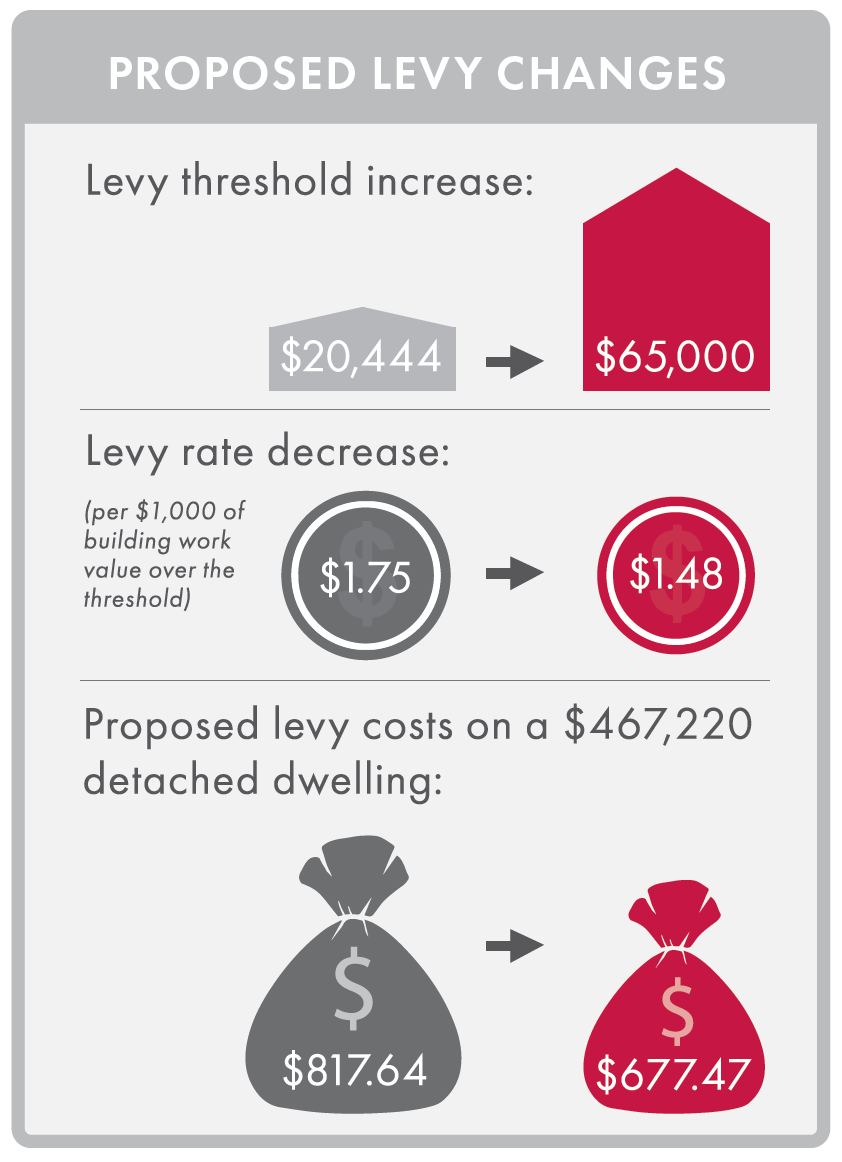Building levy fees could drop
22 May 2023, Industry Updates, News

Consultation has now closed for three proposed changes to the building levy that could reduce fees for builders. Interested parties had until May 29 to have their say. For those who missed out, here’s an in-depth look into what changes were discussed
The Ministry of Building, Innovation and Employment (MBIE) has closed feedback to the changes which increase the building levy threshold and reduce the levy rate. The building levy is a charge calculated on the cost of building work and is paid by building owners or developers on successful building consent applications for projects worth more than the threshold (currently $20,444, including GST).
The three proposed changes will increase the levy threshold, reduce the levy rate and increase investment in MBIE’s building regulatory function. MBIE’s proposal would increase the levy threshold from $20,444 to $65,000 and reduce the levy rate to $1.48 from $1.75 per $1,000 of building work value over the threshold. MBIE says that if the proposed changes become law, on a $467,220 detached dwelling, the levy costs would reduce from around $817.64 to $677.47. For a $20m commercial build, the levy costs would reduce from $35,000 to $29,000.
Any revenue the building levy collects is used to fund MBIE functions and activities, as stipulated in the Building Act 2004.
Shore Build director Ash Hare believes that the building levy pays its way, thanks to the work it does in the background.
“I think the building levy is appropriate. If you look at the work councils and organisations like BRANZ do to provide us with a framework to work within, plus research on methods and products, then I believe the levy is a worthwhile price to pay. They’ve got to be funded somehow!”
Five areas to address
As well as increasing the levy threshold and reducing the levy rate, the proposed changes want to address five issues with the current levy.
- The current levy has generated a significant surplus, which is undesirable in terms of good practice.
- The current levy threshold does not reflect current building costs, as it hasn’t been adjusted for 30 years.
- MBIE’s digital and other engagement channels do not fully meet the needs of its stakeholders.
- MBIE is facing increasing costs in delivering better compliance pathways to the building sector.
- MBIE is facing increasing costs in delivering building for climate change regulation.
The consultation is a result of the 2021 Building Levy Baseline Review, in which MBIE sought to assess the performance of MBIE’s building system regulator function and to measure the current cost base of the system and likely future funding needs.
The review also recommended opportunities for continuous improvement, in response to which MBIE developed an uplift programme which identified:
- MBIE’s digital and other engagement channels do not fully meet the needs of its stakeholders.
“To strengthen the quality and volume of the information, education, and guidance provided, MBIE is now looking to progress a programme of work to lift its digital capability and better support its information, education, and operational policy functions to deliver through improved digital channels,” stated the Building Levy Review.
- MBIE is facing increasing costs in delivering better compliance pathways to the building sector.
“MBIE’s regulatory reform programme is identifying a range of improvements that can be made to enhance the performance of the sector, including improving guidance to support greater compliance, and improving the safety and resilience of our built environment to the benefit of New Zealanders,” the review stated.
MBIE is facing increasing costs in delivering regulations around building for climate change.
Account surplus
However, the good news for tradies is that the building levy memorandum account has a $71.6m surplus. In part, this is due to the levy threshold not being changed to reflect inflation for 30 years – aside from a small increase from $20,000 to $20,444 to reflect the GST change from 12.5% to 15%.
In an attempt to eliminate the surplus, it is proposed that the levy threshold increase and the levy rate reduce. An increase in the levy threshold will eliminate building levy costs for 36% of consents, said MBIE.
To further reduce the surplus, MBIE “is keen to improve effectiveness through the delivery of fit-for-purpose services and support to the building sector to improve efficiency and lower costs for the sector and consumers”.
Proposed changes
MBIE sets out its arguments for each proposed change in the Building Levy Review and details how it considered setting the levy threshold at $40,000. However, it argues: “while adjusting the threshold to $40,000 is a feasible option, MBIE does not consider this option achieves the policy intent of reflecting inflation over the period since the threshold was first set”.
It also states that the levy rate and threshold will be reviewed every three years.
It will increase investment in MBIE services, at an estimated cost of $6.3m per annum, from the surplus that currently exists.
Under the proposed scenario of increasing the threshold to $65,000 and reducing the levy to $1.48, the surplus would “trend towards zero” over three-and-a-half years.
Register to earn LBP Points Sign in


